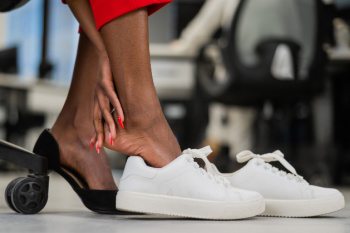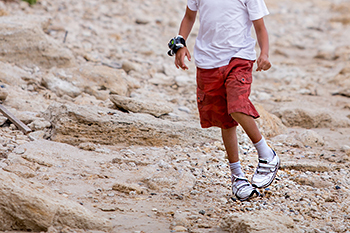Items filtered by date: August 2024
Common Types of Foot Surgery

Foot surgery can address various conditions to relieve pain and improve function. Bunion surgery is performed to correct the deformity of the big toe joint, often involving realignment of the bones. Fusion surgery, typically for severe arthritis, involves joining two or more bones in the foot to reduce pain and stabilize the joint. Hammertoe surgery corrects the abnormal bending of the toes, which can cause discomfort and difficulty walking. Heel surgery addresses issues such as chronic pain or deformities, often involving procedures to repair or realign the heel bone. Additionally, neuroma surgery is used to remove or reduce the swelling of a nerve, usually between the toes, to alleviate pain and discomfort. Each type of surgery aims to address specific foot problems and improve overall mobility and quality of life. If you have a foot condition that may require surgery for relief, it is suggested that you consult a podiatrist who can determine if this is a right choice for you.
Foot surgery is sometimes necessary to treat a foot ailment. To learn more, contact Donovan Gowdie, DPM of The Foot & Ankle Treatment Center. Our doctor will assist you with all of your foot and ankle needs.
When Is Surgery Necessary?
Foot and ankle surgery is generally reserved for cases in which less invasive, conservative procedures have failed to alleviate the problem. Some of the cases in which surgery may be necessary include:
- Removing foot deformities like bunions and bone spurs
- Severe arthritis that has caused bone issues
- Cosmetic reconstruction
What Types of Surgery Are There?
The type of surgery you receive will depend on the nature of the problem you have. Some of the possible surgeries include:
- Bunionectomy for painful bunions
- Surgical fusion for realignment of bones
- Neuropathy decompression surgery to treat nerve damage
Benefits of Surgery
Although surgery is usually a last resort, it can provide more complete pain relief compared to non-surgical methods and may allow you to finally resume full activity.
Surgical techniques have also become increasingly sophisticated. Techniques like endoscopic surgery allow for smaller incisions and faster recovery times.
If you have any questions please feel free to contact our office located in Watkinsville, GA . We offer the newest diagnostic and treatment technologies for all your foot and ankle needs.
Diagnosing Heel Pain

The heel, the largest bone in the foot, plays an important role in walking and weight-bearing, absorbing shock and providing stability. Heel pain is a common issue with various causes. Plantar fasciitis, characterized by inflammation of the plantar fascia, leads to sharp, morning heel pain. Heel spurs, which are calcium deposits on the heel bone, can cause discomfort with prolonged standing or walking. Sever's disease, prevalent in growing children, results from inflammation of the heel growth plate. These conditions necessitate professional assessment. If you or a family member suffers from heel pain, it is suggested that you consult a podiatrist for a proper diagnosis, identify the underlying cause, and recommend appropriate treatments.
Many people suffer from bouts of heel pain. For more information, contact Donovan Gowdie, DPM of The Foot & Ankle Treatment Center. Our doctor can provide the care you need to keep you pain-free and on your feet.
Causes of Heel Pain
Heel pain is often associated with plantar fasciitis. The plantar fascia is a band of tissues that extends along the bottom of the foot. A rip or tear in this ligament can cause inflammation of the tissue.
Achilles tendonitis is another cause of heel pain. Inflammation of the Achilles tendon will cause pain from fractures and muscle tearing. Lack of flexibility is also another symptom.
Heel spurs are another cause of pain. When the tissues of the plantar fascia undergo a great deal of stress, it can lead to ligament separation from the heel bone, causing heel spurs.
Why Might Heel Pain Occur?
- Wearing ill-fitting shoes
- Wearing non-supportive shoes
- Weight change
- Excessive running
Treatments
Heel pain should be treated as soon as possible for immediate results. Keeping your feet in a stress-free environment will help. If you suffer from Achilles tendonitis or plantar fasciitis, applying ice will reduce the swelling. Stretching before an exercise like running will help the muscles. Using all these tips will help make heel pain a condition of the past.
If you have any questions please contact our office located in Watkinsville, GA . We offer the newest diagnostic and treatment technologies for all your foot and ankle needs.
Clubfoot and the Ponseti Method for Treatment

Clubfoot is a congenital foot condition where one or both feet are abnormally rotated inward and downward. This condition, present at birth, can restrict a child's ability to walk and may lead to mobility issues if left untreated. The Ponseti method is a widely recognized treatment approach for clubfoot, focusing on gentle manipulation and casting to correct the foot's position. This method involves a series of weekly castings to gradually realign the foot, followed by the use of a brace to maintain the corrected position and prevent recurrence. The Ponseti method, a non-surgical approach, has a high success rate and offers a significant improvement in foot function and appearance. If your child has been born with clubfoot, it is strongly suggested that you include a podiatrist on your healthcare team for optimal correction results.
Congenital foot problems require immediate attention to avoid future complications. If you have any concerns, contact Donovan Gowdie, DPM of The Foot & Ankle Treatment Center. Our doctor can provide the care you need to keep you pain-free and on your feet.
Congenital foot problems are deformities affecting the feet, toes, and/or ankles that children are born with. Some of these conditions have a genetic cause while others just happen. Some specific foot ailments that children may be born with include clubfeet, polydactyly/macrodactyly, and cleft foot. There are several other foot anomalies that can occur congenitally. What all of these conditions have in common is that a child may experience difficulty walking or performing everyday activities, as well as trouble finding footwear that fits their foot deformity. Some of these conditions are more serious than others. Consulting with a podiatrist as early as possible will help in properly diagnosing a child’s foot condition while getting the necessary treatment underway.
What are Causes of Congenital Foot Problem?
A congenital foot problem is one that happens to a child at birth. These conditions can be caused by a genetic predisposition, developmental or positional abnormalities during gestation, or with no known cause.
What are Symptoms of Congenital Foot Problems?
Symptoms vary by the congenital condition. Symptoms may consist of the following:
- Clubfoot, where tendons are shortened, bones are shaped differently, and the Achilles tendon is tight, causing the foot to point in and down. It is also possible for the soles of the feet to face each other.
- Polydactyly, which usually consists of a nubbin or small lump of tissue without a bone, a toe that is partially formed but has no joints, or an extra toe.
- Vertical talus, where the talus bone forms in the wrong position causing other bones in the foot to line up improperly, the front of the foot to point up, and the bottom of the foot to stiffen, with no arch, and to curve out.
- Tarsal coalition, when there is an abnormal connection of two or more bones in the foot leading to severe, rigid flatfoot.
- Cleft foot, where there are missing toes, a V-shaped cleft, and other anatomical differences.
- Macrodactyly, when the toes are abnormally large due to overgrowth of the underlying bone or soft tissue.
Treatment and Prevention
While there is nothing one can do to prevent congenital foot problems, raising awareness and receiving neonatal screenings are important. Early detection by taking your child to a podiatrist leads to the best outcome possible.
If you have any questions please feel free to contact our office located in Watkinsville, GA . We offer the newest diagnostic tools and technology to treat your foot and ankle needs.
Signs of a Sprained Foot and Relief Methods

A sprained foot can vary in severity, with common signs including pain, swelling, and bruising surrounding the affected area. Mild sprains involve stretching or slight tearing of ligaments, causing minimal swelling and discomfort. Moderate sprains result in more significant pain, swelling, and difficulty in bearing weight. Severe sprains, characterized by complete ligament tears, often cause intense pain, extensive swelling, and instability in the foot. Relief methods for sprained feet typically involve resting the foot, compression with a bandage to support the injured area, and elevating the foot above heart level to minimize swelling. Pain relievers can help to manage pain and inflammation. Severe sprains may require medical evaluation and possibly immobilization with a brace or cast, in addition to performing specific stretches to regain strength and range of motion in the foot. If you have sprained your foot, it is suggested that you contact a podiatrist who can offer you effective relief and treatment methods.
Ankle sprains are common but need immediate attention. If you need your feet checked, contact Donovan Gowdie, DPM from The Foot & Ankle Treatment Center. Our doctor can provide the care you need to keep you pain-free and on your feet.
How Does an Ankle Sprain Occur?
Ankle sprains take place when the ligaments in your ankle are torn or stretched beyond their limits. There are multiple ways that the ankle can become injured, including twisting or rolling over onto your ankle, putting undue stress on it, or causing trauma to the ankle itself.
What Are the Symptoms?
- Mild to moderate bruising
- Limited mobility
- Swelling
- Discoloration of the skin (depending on severity)
Preventing a Sprain
- Wearing appropriate shoes for the occasion
- Stretching before exercises and sports
- Knowing your limits
Treatment of a Sprain
Treatment of a sprain depends on the severity. Many times, people are told to rest and remain off their feet completely, while others are given an air cast. If the sprain is very severe, surgery may be required.
If you have suffered an ankle sprain previously, you may want to consider additional support such as a brace and regular exercises to strengthen the ankle.
If you have any questions please feel free to contact our office located in Watkinsville, GA . We offer the newest diagnostic and treatment technologies for all your foot and ankle needs.
